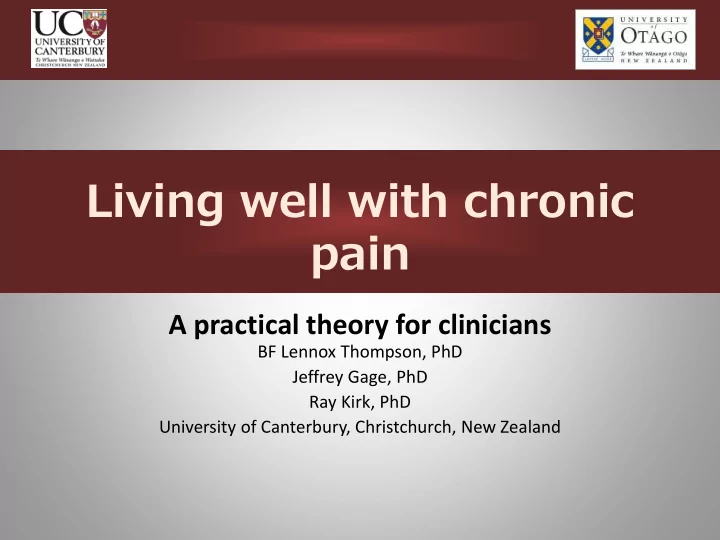

Living well with chronic pain A practical theory for clinicians BF Lennox Thompson, PhD Jeffrey Gage, PhD Ray Kirk, PhD University of Canterbury, Christchurch, New Zealand
What do you do when you see something weird?
First steps
And then I enrolled in a PhD • To explore my observation that some people live well despite – Having moderate pain levels – Not being seen at pain management centres – There being no cure for their pain problem
Living well with chronic pain • Rarely studied because? – Difficult to access – Not demanding (ie uses few resources, not a priority) – Research focus is typically on what doesn’t work • Little existing theory BUT • A consistent minority • An empirical regularity (eg Karoly & Ruehlman, 2006; Mortimer, Ahlberg & Group, 2003; Dominick, Blyth & Nicholas, 2011) • Could we learn from them?
Why not test a hypothesis? • Existing theory explains disability , not resilience • No reasonable hypotheses to test • Many assumptions needed to test hypotheses, with limited empirical basis • Relatively small population • Wanting to begin with individual experience first Paul Thurlby for the Guardian
Why grounded theory? • Uses “real world” data to generate theoretical relationships (hypotheses) between abstract concepts • Systematic, complete methodology, not just a set of methods • Answers the questions of why and how • Especially in the absence of theoretical explanation • Reduces the problem of developing weak theory • Pragmatic – must fit, work, be relevant and modifiable
How does it work? • Developed by Glaser & Strauss in 1964/65 • Divergent development since then – Glaser’s Classical GT (pragmatist, realist) – Strauss and Corbin’s GT (post -positivist) – Charmaz’ constructivist GT(constructivist) • All feature – Constant comparison – Purposive iterative sampling – Coding and sampling carried out from the beginning – Codes derived from the data rather than from pre-existing theory – Saturation – Abductive reasoning
Why useful in pain research? • Pain is subjective, rely on people telling us what is going on • Enables strong hypotheses to be developed for future testing • Allows for novel phenomena to be explored • Examines and explains processes, interactions both social and individual • Integrates existing research • Can directly inform clinical practice
Research strategy • Identify members of the “resilient” population • Ask them about their “main concern” • Examine how they resolve their main concern using data from them and about them – Data can be qualitative or quantitative • Constant comparison – systematically compare each incident with each incident to develop concepts and relationships
Research Process • Identify core concept - saturation – coding is then focused on codes relevant to the core concept • Develop theoretical coding (relationships between the core and subsequent concepts) • Memos document thoughts, hypotheses, theoretical reflections and potential relationships • Literature is integrated during theoretical coding
Re-occupying self • Main concern = achieving self-coherence • Being comfortable with the self again • Living with the self, knowing and integrating aspects of self including self-with-pain • Integrate the effects of pain on capabilities, but pain does not define the self • Occupations used to understand meaning of pain, represent/enact valued aspects of self, elicit need for coping
Main concern = achieving self-coherence Re-occupying self Making Flexibly Deciding to get on with sense persisting life Diagnostic Symptom Occupational Occupational Future Coping clarity understanding existing engaging planning Turning Point decision is influenced by a Trustworthy Clinician and Occupational Drive
“The real travesty of pain isn’t the pain part, it’s the failing to live part”
Implications • Learning to “live well” is a process – takes time • “Tasks” within each phase need to be completed before moving forward • If tasks incomplete, individuals may be distressed, disabled, stuck • Treatment providers influential • Coping is contextual, functional not categorical
How this theory can be used • Aligns well with ACT • Consider the person’s place in the process of re - occupying self • Provide support appropriate for this phase • Be explicit about: – Chronicity – Safety to move – Your contribution as “trustworthy” support • Enable symptom understanding – help develop awareness of patterns/variations in pain
How this theory can be used • Light the fire! Identify occupation the person is passionate about • THEN you can expand the coping repertoire and how flexibly strategies are applied • Use decisional balance when deciding • Use NNT as part of deciding about treatment • Values clarification can be useful if the person can’t resume usual occupations
Contentious aspects • Accepting pain as ongoing – Some argue that pain reduction should be an ongoing focus • Symptom understanding – Includes monitoring variations, influences – Contrary to behavioural model • Occupational existing – Inability to plan for the future while making sense
Contentious aspects • Coping strategies – Contextual, not “active vs passive” – Range of strategies – Willingness to learn these depends on position in process • Emphasis on re-occupying self – Often not explicitly discussed – Requires focus on occupations the person values, not always “work” – Return to employment may be easier if the person gains confidence within a less demanding or more rewarding occupation (highly valued)
Limitations • Substantive theory • Probable explanation (abductive reasoning) • Need to test hypotheses in different populations • Population initially drawn from people with rheumatological conditions, may not apply to all people with chronic pain
More from Jo
Acknowledgements My supervisors Dr Ray Kirk and Dr Jeff Gage, University of Canterbury My colleagues at Dept of Orthopaedic Surgery & Musculoskeletal Medicine, University of Otago, Christchurch The participants who shared their experiences, and particularly Joletta Belton for allowing me to share excerpts from her blog
Recommend
More recommend